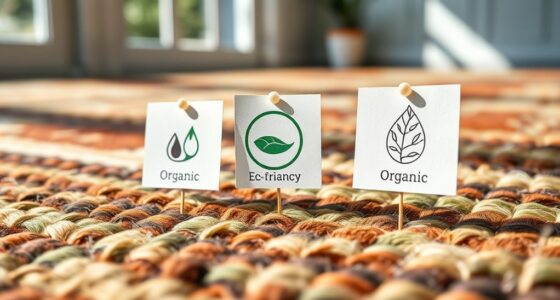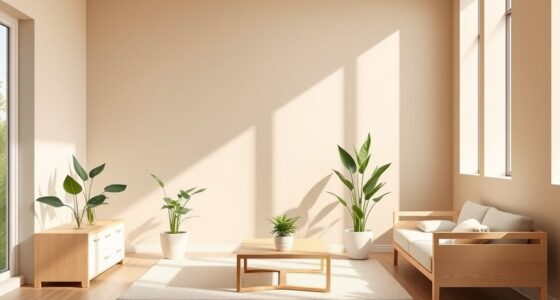As natural dyes age, you’ll notice two main effects: patina and fade. Patina forms a thin surface layer that enhances depth and warmth, creating a subtle, aged glow. Fade, on the other hand, involves a gradual loss of vibrancy and color intensity, often caused by sunlight, pollution, or environmental factors. Understanding how these processes change the appearance of your dyes helps you care for them better—keep exploring to learn how to preserve their beauty over time.
Key Takeaways
- Patina develops over time through chemical reactions, creating a subtle surface layer that enhances depth and warmth in natural dyes.
- Fade involves the loss of vibrancy and brightness due to environmental factors like sunlight, moisture, and pollutants.
- Patina preserves or even enriches the appearance, often adding a glossy or nuanced surface, while fade dulls the color and reduces vibrancy.
- Factors such as exposure to UV light, humidity, and air quality influence whether natural dyes develop patina or fade.
- Preservation techniques like gentle cleaning, natural sealants, and protection from light help promote patina formation and prevent fading.
The Nature of Natural Dyes and Their Aging Process
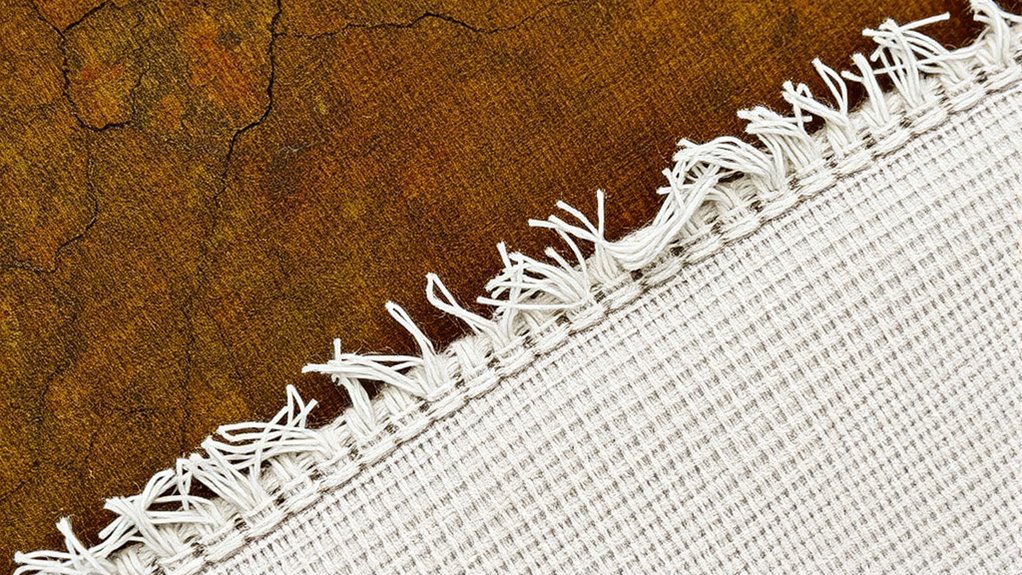
Natural dyes, derived from plants, minerals, and insects, have been used for centuries to color textiles, but their appearance and durability can change over time. Their chemical stability plays a pivotal role in how well they resist fading and deterioration. Unlike synthetic dyes, natural dyes often rely on dye mordants—substances that fix the color to fibers—improving their longevity. The choice of mordant affects not only the vibrancy but also the dye’s resistance to light, washing, and environmental factors. Over time, natural dyes may fade or develop a patina, but their initial chemical stability and the effectiveness of mordants determine how they age. The type of fibers used also influences how dyes age, as different materials interact uniquely with natural pigments. Understanding these factors helps you appreciate the unique qualities and aging process of natural-dyed textiles.
What Is Patina and How Does It Develop?

A patina is a thin, surface layer that develops on dyed textiles over time, giving them a distinct, often subtle appearance. This process results from natural chemical reactions between the dye and environmental factors like light, air, and moisture. These reactions can enhance pigment stability, preserving the color’s integrity while creating a unique, aged look. To understand how patina forms, consider:
Patina on textiles develops through natural chemical reactions, creating a subtle, aged beauty over time.
- Chemical reactions modify the dye’s surface, producing a change in appearance without affecting overall dye integrity.
- Environmental exposure gradually influences the dye, leading to a subtle shift in hue or sheen.
- The stability of natural pigments determines how well the dye ages, with more stable pigments developing a richer patina over time. This process makes each piece uniquely beautiful and full of character.
- Different dye types, such as natural dyes, age differently, contributing to a variety of patina effects.
Understanding Fade: Causes and Characteristics
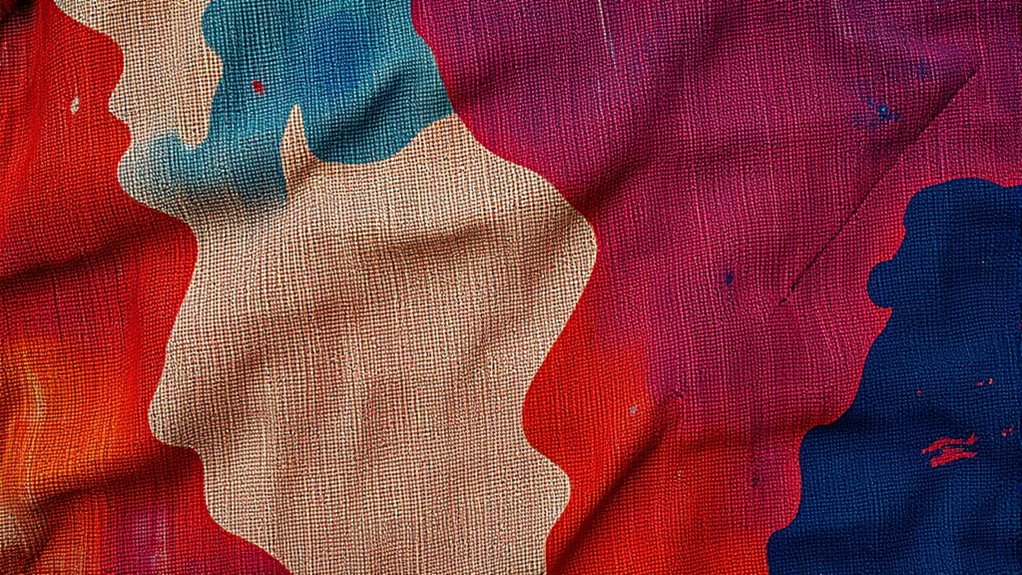
Fading occurs when the vibrant colors of dyed textiles gradually diminish due to various environmental and chemical factors. Exposure to sunlight, heat, moisture, and pollutants accelerates the breakdown of natural pigments, causing colors to lose their intensity. Unlike synthetic alternatives, natural dyes often have lower chemical stability, making them more susceptible to fading over time. Chemical stability refers to how well a dye resists chemical reactions that cause color deterioration. Natural dyes tend to be more vulnerable because they are composed of complex organic compounds that react with environmental agents. When these dyes fade, they don’t just lose brightness; the process can also alter the hue, leading to uneven or dull appearances. Additionally, eco-friendly materials used in sustainable fashion can influence dye longevity, as some natural fibers and dyes interact differently with environmental factors. Understanding these causes helps you appreciate why natural dyes require careful care to maintain their vibrancy.
Factors Influencing the Aging of Natural Colors
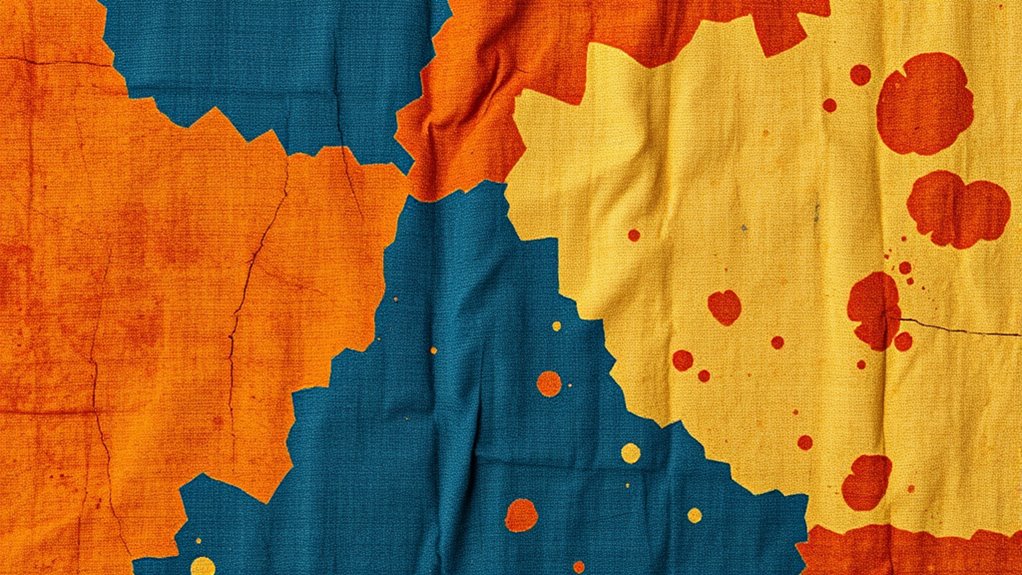
You’ll notice that natural colors change over time based on several factors. Sunlight exposure can accelerate fading, while the material you use influences how well the colors hold up. Environmental humidity also plays a role, affecting how colors age and degrade. Additionally, the type of dye and the quality of the materials used can significantly impact the color stability over time.
Exposure to Sunlight
Exposure to sunlight accelerates the deterioration of natural dyes by breaking down the chemical compounds responsible for their vibrant colors. UV exposure causes pigment stability to decline, leading to fading over time. To protect your textiles, consider these steps: 1. Limit direct sunlight exposure, especially during peak hours. 2. Use UV-protective coatings or treatments to shield dyes. 3. Store items in dark, cool areas when not in use. Additionally, implementing vertical storage solutions can help organize items and reduce unnecessary handling, further preserving their color integrity.
Material Composition Differences
The material composition of textiles plays a crucial role in how natural dyes age over time. Different fibers influence chemical interactions and dye stability, affecting whether colors fade or develop a patina. Natural fibers like wool, silk, and cotton have unique properties that interact differently with dyes. For example, silk’s smooth surface enhances dye retention, while cotton’s porous structure can lead to faster fading. The table below illustrates these differences:
| Fiber Type | Chemical Interaction | Effect on Dye Stability |
|---|---|---|
| Wool | Forms hydrogen bonds | Maintains color longer |
| Silk | Stronger dye affinity | Promotes patina |
| Cotton | Less chemical bonding | Fades faster |
Understanding these variations helps you predict how natural dyes will age on different materials, especially considering their fiber properties, which are essential for predicting dye behavior over time.
Environmental Humidity Levels
Environmental humidity levels substantially influence how natural dyes age on different textiles. Humidity effects can accelerate or slow down dye deterioration through moisture impact. When humidity is high, fibers absorb more moisture, which can lead to fading, mold, or uneven patina development. Conversely, low humidity causes fibers to dry out, making dyes brittle and prone to cracking. To manage humidity effects, consider these tips:
- Maintain consistent indoor humidity levels between 40-60% to prevent rapid moisture fluctuations.
- Use dehumidifiers or humidifiers to control moisture impact in your storage or display spaces.
- Avoid exposing textiles to extreme environment changes, as fluctuating humidity accelerates aging and color loss.
- Be aware that data privacy challenges can influence how cultural artifacts and textiles are stored and documented digitally, ensuring sensitive information is protected.
Controlling environmental humidity levels helps preserve the integrity and beauty of natural dyes over time.
Comparing Patina and Fade: Visual and Textural Changes
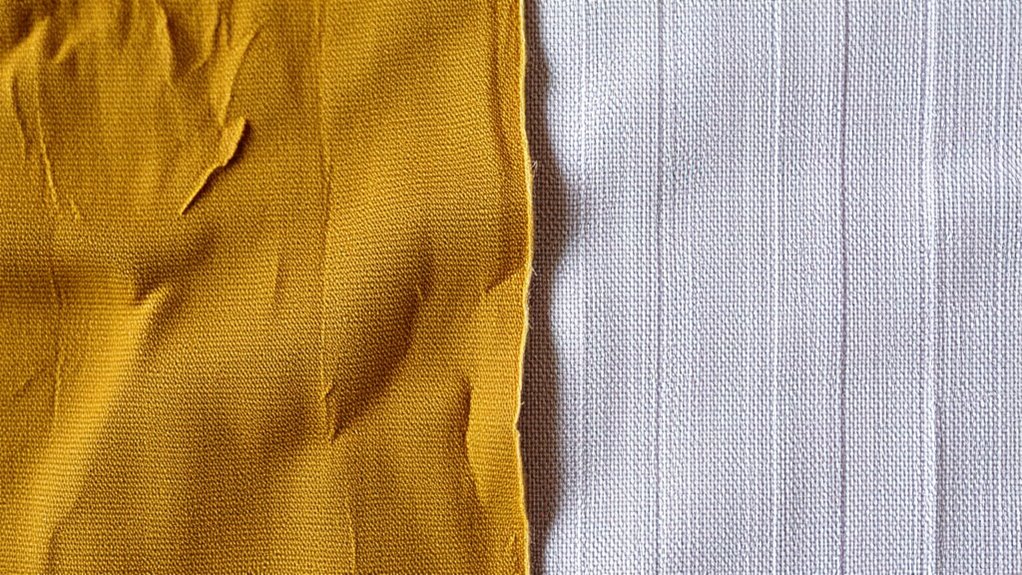
As natural dyes age, they develop distinct visual and textural changes that can either enhance or diminish their appeal. Patina creates a subtle, often glossy finish with depth and warmth, developing gradually through gentle chemical reactions over time. Fade, however, results in a lighter, more uniform appearance, often making the fabric look worn or less vibrant. Unlike synthetic alternatives, which are designed to resist change, natural dyes undergo ongoing chemical reactions that alter their appearance. Patina tends to preserve the richness of the original dye, adding character, while fade can strip away vibrancy, creating a softer, more muted look. Texturally, patina may add a slight roughness or smoothness, whereas fade often results in a more consistent surface. These changes influence how you perceive the aging process visually and tactilely.
The Role of Light, Air, and Environment in Dying Outcomes

You’ll notice that sunlight can exceptionally alter the color of natural dyes over time, causing fading or changes in hue. Air quality influences how quickly dyes degrade or develop patina, depending on pollutants and moisture levels. Environmental factors like humidity also play a vital role, affecting how dyes age and how well they retain their vibrancy. Additionally, exposure to certain precious metals can impact the aging process and visual appearance of dyed materials over extended periods.
Sunlight’s Impact on Color
Sunlight plays a essential role in how natural dyes age over time, directly affecting their vibrant hues. Exposure to UV rays can cause botanical pigments to fade, reducing dye stability. To understand this impact, consider these points:
- Prolonged sunlight exposure accelerates fading, especially in bright, direct light.
- UV rays break down chemical bonds in dyes, leading to color loss.
- Protecting items from light—using coverings or display in low-light areas—helps preserve their original vibrancy and prolongs dye stability.
Air Quality Effects
Environmental air quality markedly influences how natural dyes age, as pollutants and airborne particles can accelerate deterioration. Pollution effects, such as dust, smoke, and chemical pollutants, settle on surfaces and break down dye molecules over time. Indoor air quality also plays a vital role; poor ventilation or exposure to airborne contaminants can lead to faster fading or uneven patina development. You might notice that objects kept in enclosed, polluted environments degrade more quickly than those in clean, well-ventilated spaces. To preserve your natural-dyed pieces, guarantee good airflow and minimize exposure to pollution effects. Regular cleaning and avoiding areas with heavy air pollution help slow down the aging process, maintaining the vibrancy and integrity of natural dyes longer. Additionally, understanding creative practice can help you develop better methods for caring for and maintaining your dyed items over time.
Environmental Humidity Factors
Humidity levels and environmental conditions considerably influence how natural dyes age, affecting both their color stability and surface integrity. High humidity effects can cause dyes to fade more quickly or develop uneven patinas, while low moisture levels help preserve vibrancy. Moisture influence plays an essential role in dye longevity:
- Excess humidity accelerates dye degradation and promotes mold growth.
- Fluctuating humidity causes expansion and contraction, leading to cracking or surface damage.
- Stable, moderate humidity preserves dye color and enhances patina development.
Techniques to Enhance Patina and Prevent Fading

To effectively enhance the patina and prevent fading of natural dyes, you should focus on proper sealing and maintenance techniques. Understanding natural dye chemistry helps you choose suitable sealants that boost color fastness without altering hues. Use breathable finishes like beeswax or natural oils to protect surfaces while allowing moisture exchange. Regular cleaning with gentle, pH-neutral products maintains vibrancy, preventing dirt buildup that can dull colors. Here’s a helpful guide:
| Technique | Purpose | Best Practices |
|---|---|---|
| Sealant application | Protects dye from environmental damage | Use thin, even layers; reapply periodically |
| Avoid harsh chemicals | Preserves natural dye integrity | Opt for pH-neutral cleansers |
| Controlled light exposure | Prevents UV fading | Keep away from direct sunlight |
| Regular maintenance | Sustains patina and color | Clean gently, monitor dye stability |
| Use of natural finishes | Enhance durability and color fastness | Opt for beeswax or oils |
Preserving Natural Dyes: Best Practices for Care and Maintenance
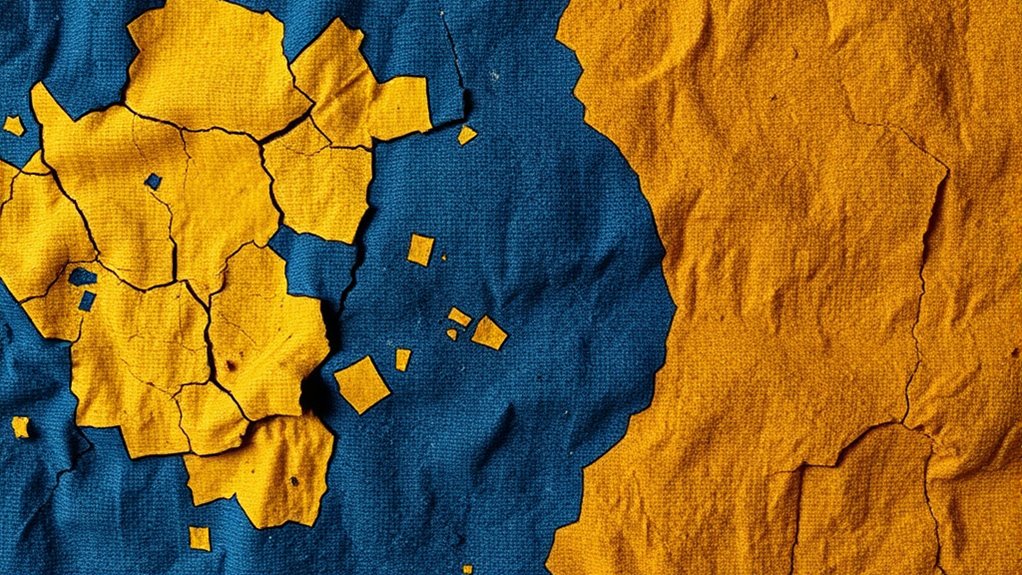
To keep your natural dyes vibrant, it’s essential to use gentle cleaning methods that avoid harsh chemicals. Proper storage, like keeping items out of direct sunlight and in stable environments, also plays a vital role. By following these best practices, you can extend the beauty and longevity of your dyed pieces. Additionally, understanding essential oil safety can help prevent accidental damage when using oils for cleaning or conditioning your textiles.
Gentle Cleaning Techniques
Because natural dyes are more delicate than synthetic ones, using gentle cleaning techniques is essential for preserving their vibrant hues over time. You want to maintain the natural pigment and dye stability, so avoid harsh chemicals and abrasive tools. Instead, follow these practices:
- Use a soft, damp cloth to gently wipe the surface, avoiding excessive moisture.
- Spot clean stains with a mild, pH-neutral soap diluted in water.
- Air dry the item away from direct sunlight to prevent fading and preserve dye integrity.
Proper Storage Methods
Proper storage plays a key role in maintaining the vibrancy and longevity of natural dyes. Understanding natural dye chemistry helps you choose appropriate conditions to prevent fading or unwanted patina. Keep dyed textiles away from direct sunlight, which accelerates pigment breakdown, and store them in a cool, dry place to inhibit mold and deterioration. Following cultural dyeing practices can also guide your storage methods; many traditions emphasize wrapping textiles in natural fibers like cotton or silk to protect against dust and light. Avoid plastic containers that trap moisture, which can cause damage over time. Instead, opt for breathable storage options. Regularly inspecting your items guarantees early detection of any issues, helping preserve their beauty and integrity for years to come.
Artistic Perspectives: Embracing Aging as Part of the Artwork’s Life
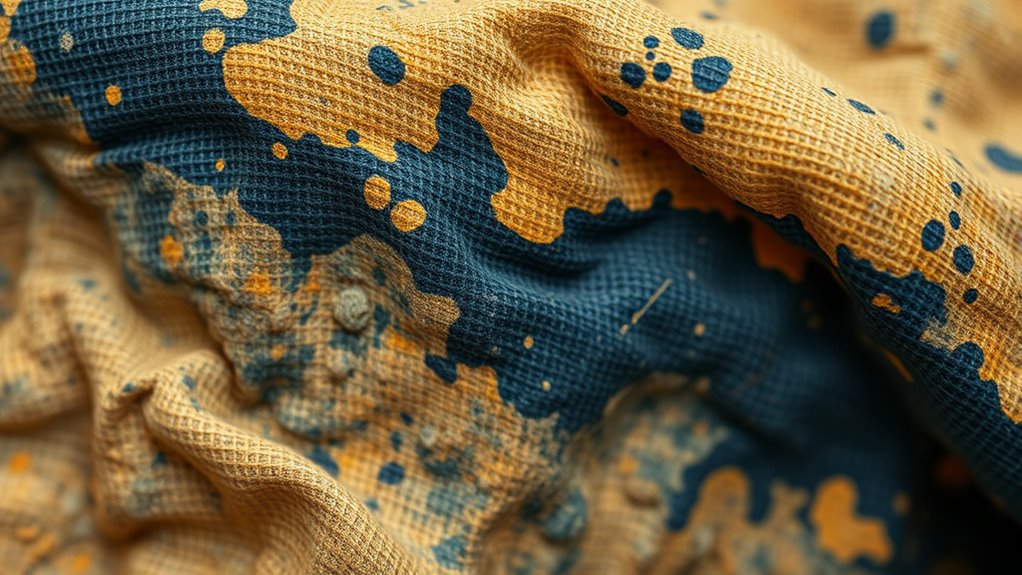
As artworks age, many artists and observers see this process not as deterioration but as an integral part of the piece’s evolving story. Embracing natural aging highlights the historical significance and cultural symbolism embedded in the colors. You can appreciate this transformation by:
- Recognizing patina as a sign of authenticity and connection to the past.
- Valuing color shifts as reflections of cultural narratives and traditions.
- Understanding that aging enriches the artwork’s character, adding depth and context.
When to Restore or Rejuvenate Natural Dyes

Knowing when to restore or rejuvenate natural dyes is crucial to maintaining the artwork’s integrity without compromising its aged character. You should consider restoration if color stability diminishes considerably or if pigment variation causes uneven fading that affects the piece’s visual harmony. If the dyes have faded uniformly, it may be better to accept the patina as part of its history. However, if certain areas lose their vibrancy more than others, gentle intervention might be necessary. Restoring too aggressively can erase the natural aging process and diminish authenticity. Rejuvenation should be reserved for cases where the artwork’s overall aesthetic or cultural value is at risk. Always evaluate whether restoring enhances the piece without sacrificing its genuine aged qualities.
Frequently Asked Questions
Can Natural Dyes Be Restored After Fading or Patina Development?
When natural dyes fade or develop a patina, you can often restore their vibrancy with gentle dye restoration techniques. Fading remedies include re-dyeing or light touch-ups, but be cautious to maintain the original look. Patina, however, adds character and can sometimes be enhanced rather than removed. Always test small areas first, and consult specialists if needed, to ensure effective dye restoration without damaging the piece.
How Does Humidity Affect the Aging Process of Natural Dyes?
Humidity effects play a significant role in dye preservation. High humidity can accelerate fading and promote mold growth, leading to uneven aging or deterioration of natural dyes. Conversely, low humidity helps maintain color stability and slows down aging, preserving the vibrancy longer. You should control humidity levels in storage areas, ensuring they’re not too damp or dry, to keep your natural dyes looking their best and aging gracefully over time.
Are Certain Natural Dyes More Prone to Fading Than Others?
Imagine your favorite natural dye piece, vibrant today, but what if it changes tomorrow? Some dyes have higher colorfastness variations, making them more prone to fading, while others boast incredible dye stability factors. You might notice indigo fades gracefully, developing a patina, whereas turmeric may fade quickly. Knowing which dyes resist fading helps you choose wisely, ensuring your artwork ages beautifully—either fading softly or developing a timeless patina.
What Are Common Misconceptions About Natural Dye Aging?
You might believe fading myths mean natural dyes always lose their vibrancy quickly, but that’s not true. Many think aging myths suggest natural dyes inevitably fade to dullness, yet some develop a beautiful patina over time. Natural dyes age uniquely depending on materials and exposure, so don’t assume fading or patina is bad. Embrace the aging process, understanding that natural dyes can deepen in richness, challenging common fading myths.
How Do Cultural Practices Influence the Aging of Natural Dyes?
You see, cultural practices deeply influence how natural dyes age, as they often involve traditional techniques that shape the dye’s development over time. By practicing cultural preservation, you help maintain authentic methods, which affect whether dyes develop a rich patina or fade gracefully. These techniques, passed down through generations, ensure the natural aging process reflects cultural identity, blending history with beauty and creating unique, meaningful patinas rather than just fading colors.
Conclusion
Embrace the beauty of aging natural dyes, understanding that patina and fade tell unique stories. Recognize that each mark, each change, adds character and authenticity, enriching your artwork’s history. Cherish the subtleties of time passing, the layers of experience, and the natural evolution that makes your piece truly alive. By respecting these processes, you honor the material, you preserve its spirit, and you celebrate the timeless dance between nature and art.


